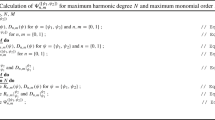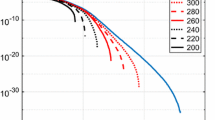Abstract
Random errors for the harmonic coefficients of a geopotential model are generated from the matrix of normal equations by a parallel computer applying the Gibbs sampler. This leads to random values for the harmonic coefficients. They are transformed by nonlinear, quadratic transformations to random values for the square roots of degree variances, of mean squares of geoid undulations and gravity anomalies. The expected values of these quantities are not equal to the values of these quantities computed by the estimated harmonic coefficients, due to correlations and errors in the estimation. By hypothesis tests estimated harmonic coefficients distorted by correlations and errors are detected. Applying the tests to the geopotential model ITG-CHAMP01 of the Institute of Theoretical Geodesy in Bonn it is concluded that above the degree 62 the harmonic coefficients cannot add any information to the geopotential model.
Similar content being viewed by others
References
Colombo O.L., 1981. Global Geopotential Modelling from Satellite-to-Satellite Tracking. Report No. 317, Department of Geodetic Science and Surveying, Ohio State University, Columbus, Ohio, USA.
ESA, 1999. Gravity Field and Steady-State Ocean Circulation Mission. ESA Publications Division, ESA SP-1233(1), ESTEC, Noordwijk, The Netherlands.
Gelman A., Carlin J.B., Stern H.S. and Rubin D.B., 2004. Bayesian Data Analysis. 2nd Ed., Chapman and Hall, Boca Raton, USA.
Gundlich B., Koch K.R. and Kusche J., 2003. Gibbs sampler for computing and propagating large covariance matrices. J. Geodesy, 77. 514–528.
Kaula W.M., 1966. Theory of Satellite Geodesy. Blaisdell, Waltham, Mass., USA.
Koch K.R., 1999. Parameter Estimation and Hypothesis Testing in Linear Models, 2nd Ed., Springer Verlag, Berlin, Germany.
Koch K.R., 2000. Einfuhrung in die Bayes-Statistik. Springer Verlag, Berlin, Germany (in German).
Koch K.R., 2002. Monte-Carlo-Simulation fur Regularisierungsparameter. Z. Geodasie, Geoinformation und Landmanagement, 127, 305–309.
Koch K.R. and Kusche J., 2002. Regularization of geopotential determination from satellite data by variance components. J Geodesy, 76, 259–268.
Koch K.R., Kusche J., Boxhammer C. and Gundlich B., 2004. Parallel Gibbs sampling for computing and propagating large covariance matrices. Z. Geodasie, Geoinformation und Landmanagement, 129, 32–42.
Mayer-Gurr T., Ilk K.H., Eicker A. and Feuchtinger M., 2005. ITG-CHAMP01: A CHAMP gravity field model from short kinematical arcs of a one-year observation period. J. Geodesy, 78, 462–480.
Reigber Ch., Schwintzer P. and Luhr H., 1999. The CHAMP geopotential mission. Boll. Geof. Teor. Appl., 40, 285–289.
Reigber Ch., Jochmann H., Wunsch J., Petrovic S., Schwintzer P., Barthelmes F., Neumayer K.-H., Konig R., Forste Ch., Balmino G., Biancale R., Lemoine J.-M., Loyer S. and Perosanz F., 2005a. Earth gravity field and seasonal variability from CHAMP. In: Ch. Reigber, H. Luhr, P. Schwintzer and J. Wickert (Eds.), Earth Observation with CHAMP-Results from Three Years in Orbit. Springer Verlag, Berlin, Germany, 25–30.
Reigber Ch., Schwintzer P., Stubenvoll R., Schmidt R., Flechtner F., Meyer U., Konig R., Neumayer H., Forste Ch., Barthelmes F., Shu S.Y., Balmino G., Biancale R., Lemoine J.-M., Meixner H. and Raimondo J.C., 2005b. A high resolution global gravity field model combining CHAMP and GRACE satellite mission and surface data: EIGEN-CG01C. J. Geodesy (in print).
Schwintzer P., Reigber Ch., Bode A., Kang Z., Zhu S.Y., Massmann F.-H., Raimondo J.C., Biancale R., Balmino G., Lemoine J.M., Moynot B., Marty J.C., Barlier F. and Boudon Y., 1997. Long-wavelength global gravity field models: GRIM4-S4, GRIM4-C4. J. Geodesy, 71, 189–208.
Sjoberg L.E., 1987. The estimation of the power spectrum and reliability of models of the Earth’s gravity field by intercomparison of independent models. Manuscripta Geodaetica, 12, 104–112.
Author information
Authors and Affiliations
Rights and permissions
About this article
Cite this article
Koch, K.R. Determining the maximum degree of harmonic coefficients in geopotential models by Monte Carlo methods. Stud Geophys Geod 49, 259–275 (2005). https://doi.org/10.1007/s11200-005-0009-1
Received:
Revised:
Accepted:
Published:
Issue Date:
DOI: https://doi.org/10.1007/s11200-005-0009-1




